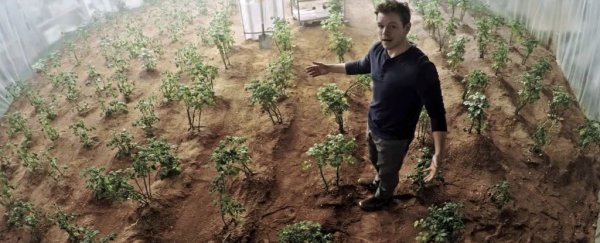In the 2015 blockbuster movie The Martian, a fictional botanist-turned-astronaut gets stranded on Mars, forcing him to "science the shit" out of his dire situation.
Mark Watney (played by Matt Damon) survives by fertilising Martian soil with his faeces, slicing up potatoes, and planting the cuttings in the soil. This eventually grows him enough food to last hundreds of days.
Growing potatoes and other food on Mars is not just a sci-fi curiosity. Now, a NASA-backed "Potatoes on Mars" experiment is showing that Watney's fictional feat might actually be possible.
NASA has eyed a crewed mission to the red planet for decades - and Congress even passed a bill that implores the space agency to reach the Red Planet by 2033. The agency is also exploring ideas of a Martian colony.
To that end, scientists at NASA and the International Potato Centre (CIP) in Lima, Peru, built a tuber-growing experiment that recreates the extreme conditions on the surface of Mars.
Everything happens inside a rocket-launchable box called a CubeSat. The CubeSat is rigged with pumps, water hoses, LED lights, and instruments to emulate Mars-like temperatures, night-and-day light cycles, gases, and air pressure.
In February 2017, researchers dumped practically lifeless soil from Peru's Pampas de la Joya desert inside, planted a tuber in it, sealed up the box, and began filming to see what happened.
"Preliminary results are positive," according to a CIP press release - which is to say a potato plant grew in inhospitable desert soil under Mars-like conditions.
"If the crops can tolerate the extreme conditions that we are exposing them to in our CubeSat, they have a good chance to grow on Mars," Julio Valdivia-Silva, a NASA researcher at the University of Engineering and Technology in Lima, said in the release.
"We will do several rounds of experiments to find out which potato varieties do best,'" he said. "We want to know what the minimum conditions are that a potato needs to survive."
Would this actually work on Mars?
The experiment doesn't provide the ironclad proof a would-be Martian potato farmer needs.
For one, the soil did not actually from Mars. Though it was arid and inhospitable, it probably still had microbes that may have helped the potato plant's growth.
The experiment also used potato cuttings instead of seeds. That's an issue because making potatoes last on a months- or years-long journey may require heating under pressure (called thermostabilisation) or a blast of radiation.
This damages the cells of a potato, "making it hard to grow plants from cuttings", Keith Cowing, the founder of NASAWatch, told Business Insider in a tweet.
However, several other experiments have shown it may be possible to grow food in Martian soil and in even-more-inhospitable moon dust, called regolith.
Bruce Bugbee, a botanist and NASA scientist at Utah State University, told Tech Insider in 2015 that there's no reason why growing potatoes or other food crops in Martian soil wouldn't work.
(He did, however, take issue with Watney mixing his faeces into the soil, which he said may be "toxic to the plants".)
The CIP, NASA, and other institutions are now looking to see how several varieties of potatoes perform in the Mars-like CubeSat box, including special varieties they have bred to withstand harsh conditions.
Aside from helping astronaut farmers of the future, the work also stands to benefit humans on Earth.
"The results indicate that our efforts to breed varieties with high potential for strengthening food security in areas that are affected, or will be affected by climate change, are working," Walter Amoros, a potato breeder at CIP, said in the organisation's release.
You can watch the experiment's potato sprout in the time-lapse video on YouTube or below:

This article was originally published by Business Insider.
More from Business Insider:

